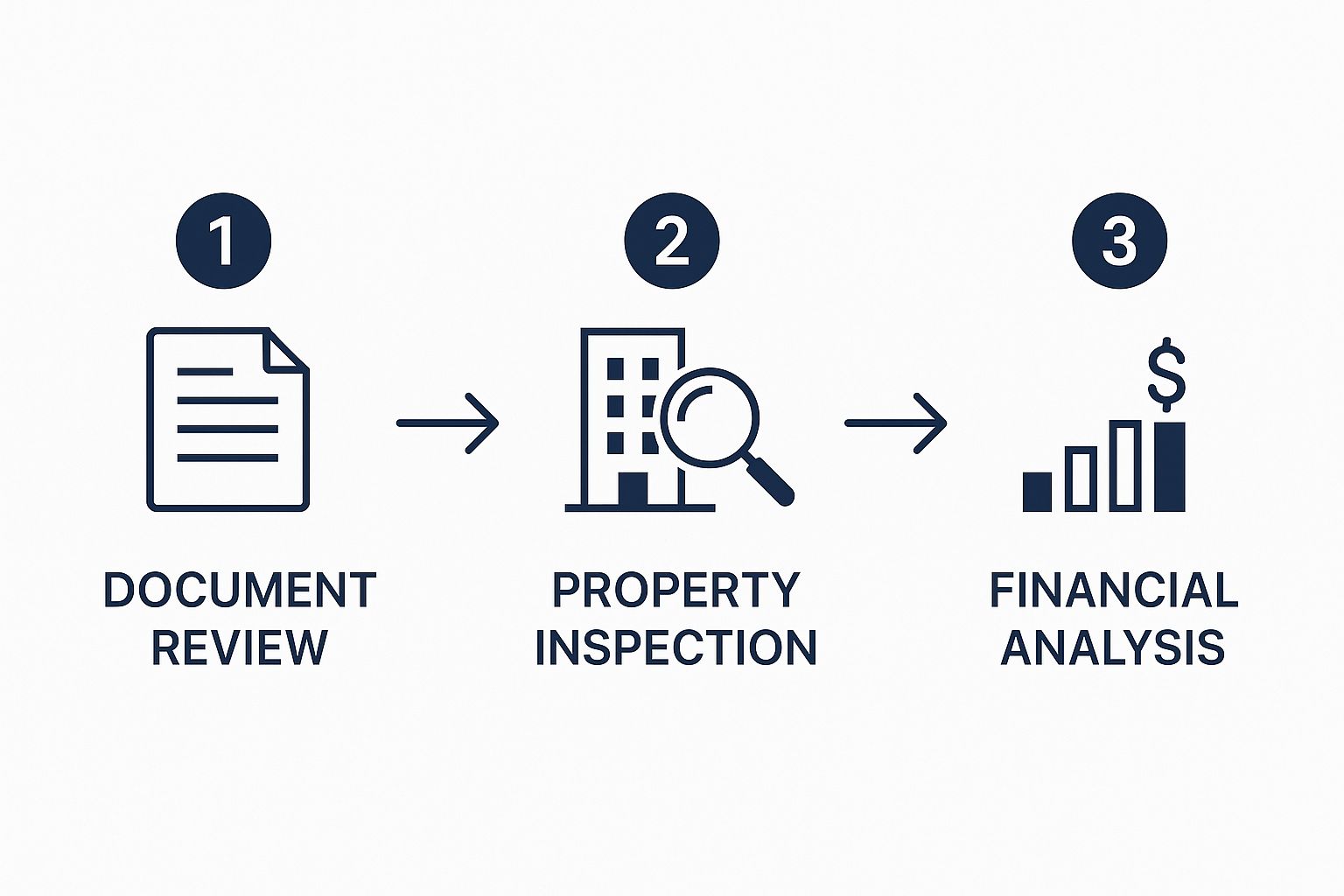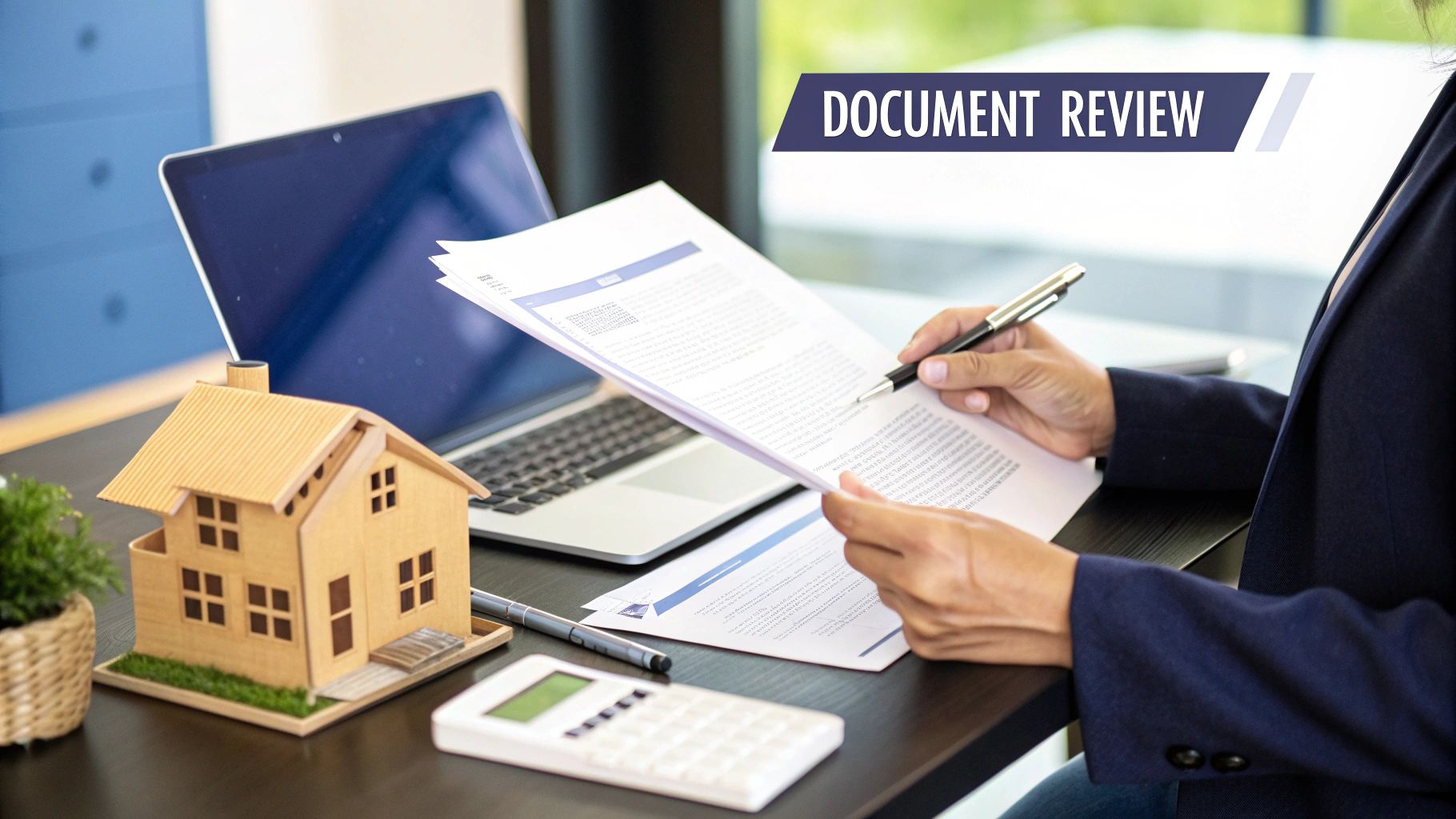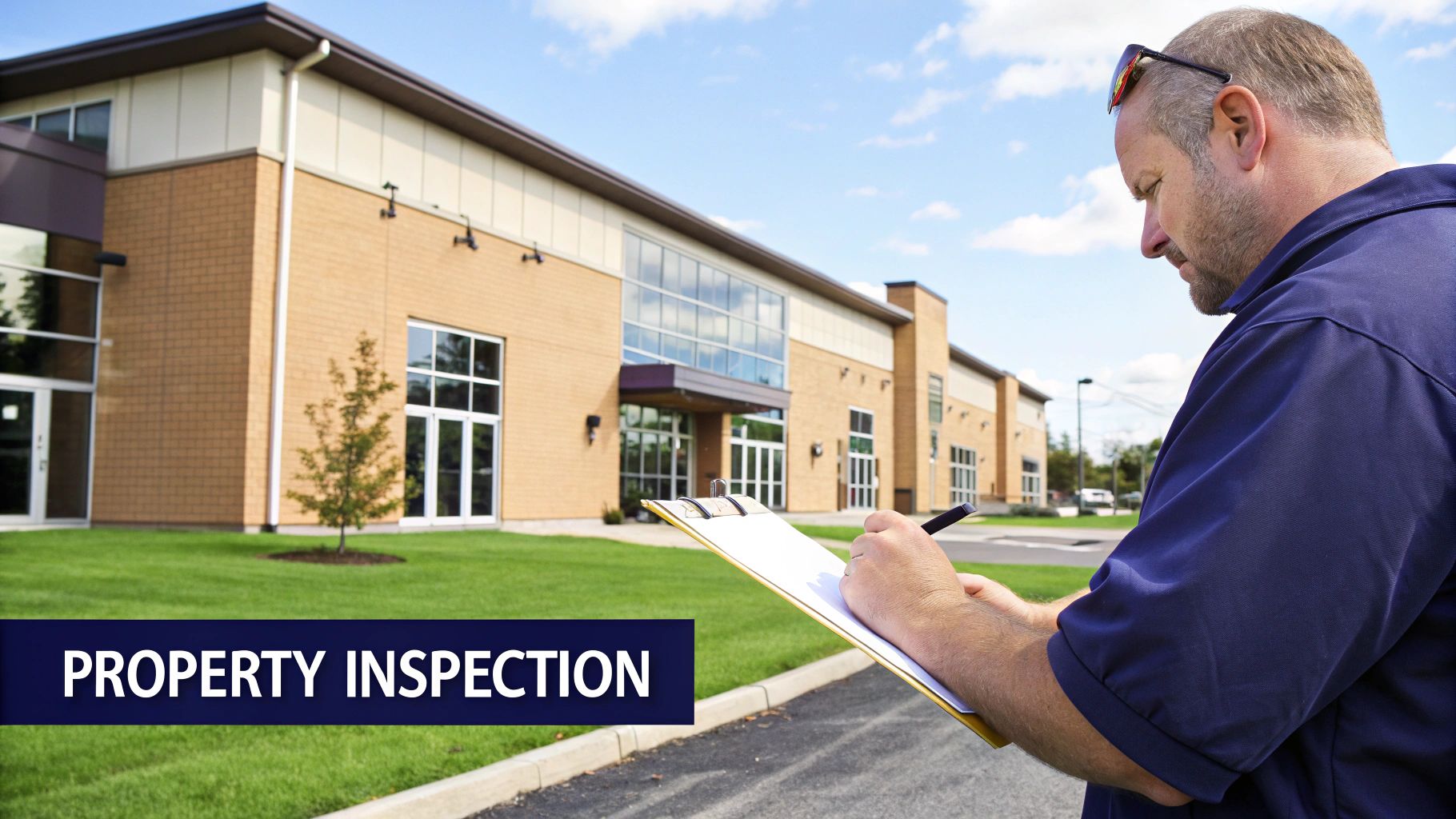A Guide to Commercial Real Estate Due Diligence: The Investor's Playbook
- Ryan McDowell

- Jul 20
- 13 min read
Reading Time: 8 min | Good for: Novice Investors (A), Family Office Principals (B), Investment Committees (C)
In commercial real estate, there's one process that single-handedly separates a profitable, sound investment from a catastrophic financial mistake: commercial real estate due diligence. This isn't just about ticking boxes. It's an exhaustive investigation into a property’s financials, physical condition, legal standing, and market position—before you commit capital. Think of it as the ultimate pre-flight check for your investment. It’s the real work that begins long before you sign on the dotted line.
TL;DR: The Bottom Line on Due Diligence
What it is: Due diligence is a comprehensive audit of a property's financial, physical, legal, and market risks before acquisition.
Why it matters: It uncovers hidden liabilities (like deferred maintenance or bad leases) and validates the seller's claims, turning potential deal-killers into powerful negotiation leverage.
Who it's for: Novice investors learn the core risks, while family offices and CIOs use it to stress-test underwriting and protect capital.
The Goal: The ultimate aim is to protect your capital. A sponsor who demonstrates institutional rigor in this phase is showing their commitment to being a good steward of your investment.
The Market Why-Now: A Shifting Landscape
The commercial real estate market is in a state of flux, making disciplined due diligence more critical than ever. According to Deloitte's 2025 Commercial Real Estate Outlook, while over 68% of CRE leaders expect fundamentals to improve, the outlook varies dramatically by sector. Industrial and multifamily sectors show strong fundamentals, while office assets face persistent headwinds. This divergence underscores that blanket optimism is dangerous; only property-specific, granular investigation can reveal true value.
Successful CRE investing isn’t built on hope; it's built on a foundation of rigorous, evidence-based verification. This process turns a potential deal-killing discovery, like an ancient HVAC system or an unresolved lien, into a powerful negotiation tool. Finding these issues gives you the leverage to renegotiate the price or secure seller credits. As noted by the team at Upper Marlboro Property Management Inc., it's a defensive strategy that pays for itself.
To make this process manageable, we break it down into four core areas. Think of them as the four pillars holding up a solid deal.
The Four Pillars of CRE Due Diligence
Diligence Pillar | Objective | Key Documents & Actions |
|---|---|---|
Financial Forensics | Verify the property's real economic performance and future potential. | - Review 3-5 years of historical operating statements.- Audit the rent roll and tenant leases.- Stress-test financial projections. |
Physical Integrity | Assess the building's condition and identify deferred maintenance or capital needs. | - Conduct a Property Condition Assessment (PCA).- Hire specialists (roof, HVAC, structural).- Order a Phase I Environmental Site Assessment. |
Legal Clarity | Ensure there are no legal roadblocks or hidden liabilities. | - Order a title report and survey.- Review zoning laws and building permits.- Examine all service contracts and vendor agreements. |
Market Viability | Understand the property's competitive position and local market dynamics. | - Analyze comparable sales and leases.- Study local supply, demand, and vacancy rates.- Research local economic and demographic trends. |
Mastering these four pillars ensures you have a 360-degree view of the asset, transforming potential oversights into calculated, manageable risks.

This roadmap shows how each step informs the next, moving from the paperwork to the physical property in a way that leaves no stone unturned.
Investor Takeaway: Due diligence isn't an expense—it's your most important investment in risk mitigation. A sponsor who treats this process with institutional rigor is demonstrating a commitment to protecting your capital above all else. Skipping a single step is a risk not worth taking.
Uncovering the Financial Truth of the Asset

A property’s story is told through its numbers, but real value is discovered by reading between the lines. Financial due diligence is a forensic audit, not a quick scan of a proforma. It's about separating optimistic projections from cold, hard economic reality. Here, we stress-test assumptions and validate every figure to build a clear picture of an asset’s genuine earning power.
The process starts by treating the seller's financial statements as a starting point, never the final word. A skilled sponsor requests several years of historical operating data, including profit and loss (P&L) statements and general ledgers. These documents show a track record of actual performance, which is far more revealing than any forward-looking spreadsheet.
Scrutinizing the Rent Roll
The rent roll is the heart of a property’s revenue. A deep dive here reveals the stability of the asset's income stream.
We immediately look for tenant concentration risk. If one tenant occupies 30% or more of the leasable space, the property's cash flow is vulnerable. If that tenant leaves, it can be a massive blow. A diverse tenant mix is a sign of a healthier, more resilient income stream.
Another critical step is to audit the leases themselves and compare them to the rent roll summary. We verify things like:
Lease Expiration Dates: Are several major leases expiring in the same year? That creates a huge rollover risk you need to plan for.
Rent Bumps: Are the contracted rent increases actually being collected? We check if they are fixed, tied to inflation (CPI), or based on a percentage of tenant sales.
Reimbursements (NNN Leases): Are tenants paying their correct share of taxes, insurance, and maintenance? Discrepancies often reveal hidden costs the owner has been absorbing.
Novice Lens: Net Operating Income (NOI) is a cornerstone metric in commercial real estate. You calculate it by subtracting all reasonable operating expenses from the property's total income. NOI is critical because it shows the pure cash flow generated by the asset before debt payments or income taxes, giving a clean view of its profitability.
Validating Operating Expenses
Wishful thinking runs rampant in proforma expense projections. Our job is to replace those wishes with hard data. We meticulously review every line item—from property taxes and insurance to repairs and management fees—and benchmark them against industry standards and the property’s own history.
A classic mistake is underestimating future property taxes, which are almost always reassessed at a higher value after a sale. Likewise, deferred maintenance can hide massive future capital expenses that don't show up on a standard P&L but will absolutely hit your returns down the line.
This level of financial digging is more critical than ever, as market sentiment varies wildly by property type. You can explore the full findings in Deloitte's commercial real estate outlook.
Deal Lens Example: The Opex Overlook
Here's a simplified, real-world example. We analyzed a $10 million retail center with a seller-provided NOI of $600,000, implying a 6.0% cap rate. On the surface, it looked solid. But during diligence, we discovered the seller "self-managed" the property and conveniently omitted a standard 4% management fee from the operating expenses.
Seller's Proforma NOI: $600,000
Realistic Management Fee: $40,000 (4% of effective gross income)
Adjusted NOI: $560,000
That single adjustment dropped the real NOI by $40,000. At the same 6.0% cap rate, the property’s true valuation is closer to $9.33 million—a $670,000 difference. This is how a small detail uncovered in diligence can completely change a deal and protect investor capital. A thorough approach to financial analysis is key; the entire process of how commercial real estate underwriting is an investor's deep dive is something we undertake on every potential acquisition.
Navigating the Labyrinth of Legal and Title Issues

If the financial audit tells you whether a deal makes sense on paper, the legal and title review tells you if the deal can actually happen. This is where skeletons—like ownership claims, usage restrictions, or surprise liabilities—often surface. This phase is about ensuring you’re buying a clean asset with the rights needed to execute your business plan. A savvy investor knows which questions to ask their legal counsel to protect their capital.
Don't Skip the Title Search
A title search confirms the seller has the legal right to sell the property. But a proper investigation goes much deeper, unearthing liens, easements, and other surprises that could limit property use or challenge your ownership.
A lien is a legal claim against the property for an unpaid debt, like from an unpaid contractor (a mechanic's lien) or the government for unpaid taxes. An easement gives someone else the right to use a piece of your property for a specific purpose, like a utility company needing access to power lines.
Investor Takeaway: Never, ever assume a title is clean. We once analyzed a prime development site where a forgotten easement gave a neighbor access right through the middle of our proposed building footprint. It was a complete deal-killer that only a thorough title search could have found.
Cracking the Code on Zoning and Land Use
Zoning codes are the local government’s rulebook for what you can build and how you can use a property. Your plan to convert an old warehouse into loft apartments is a non-starter if local zoning forbids residential use.
Verifying zoning involves confirming the property's current use is legal ("legal and conforming") and ensuring your future plans are allowed. This means digging into:
Permitted Uses: What can the property be used for without special approval?
Setbacks and Height Limits: How close to the property line can you build, and how high?
Parking Requirements: Does your plan account for the minimum number of parking spaces?
Historical Designations: Are there restrictions on changing the building's facade or structure?
Scrutinizing Every Contract and Permit
Finally, you must review every document tied to the property, including service contracts, equipment leases, and past building permits. You’re hunting for any contracts that are tough to terminate or have unfavorable terms you’ll inherit.
Missing permits for previous renovations are a massive red flag. They often point to uninspected work that could be a safety hazard or require expensive fixes to bring everything up to code.
As detailed on the Skyline Title Support blog, modern title investigation now requires deep dives into complex corporate ownership and property-specific regulations, which can reveal development limitations or expensive cleanup duties. The key is securing the right insurance and carefully documenting how every exception is handled.
Assessing Physical and Environmental Risks
It’s time to move from spreadsheets to the physical structure itself. This is where we get our hands dirty to uncover tangible risks that can silently drain returns. What you find in the walls and under the ground is just as important as what you find in the financial statements.
Decoding the Property Condition Assessment
We always start with a comprehensive Property Condition Assessment (PCA). This is a top-to-bottom expert review of the entire building handled by specialized engineers and consultants.
They meticulously inspect:
Structural Integrity: The foundation, walls, and load-bearing elements.
Roofing Systems: The age, condition, and remaining useful life.
HVAC Systems: The condition of heating, ventilation, and air conditioning units—often one of the biggest future capital expenses.
Plumbing and Electrical: The state of pipes, wiring, and panels.
Life Safety Systems: Fire alarms, sprinklers, and emergency exits.
Investor Takeaway: A PCA isn’t just about finding problems; it’s about pricing them. The report provides an "Immediate Repairs Table" and a "Capital Reserve Schedule," allowing a sponsor to accurately budget for future costs and use current deficiencies as leverage to renegotiate the purchase price.
Uncovering Environmental Liabilities
Alongside the physical inspection, we launch environmental due diligence to ensure we aren’t inheriting a costly cleanup problem. The process starts with a Phase I Environmental Site Assessment (ESA), a background check on the property's history to identify any "Recognized Environmental Conditions" (RECs)—the potential presence of hazardous substances.
If the Phase I report raises red flags, a Phase II ESA is the next step, involving physical soil and groundwater sampling. Finding an issue isn't automatically a deal-breaker, but it dramatically changes the negotiation.
Deal Lens Example: The Hidden Tank
On a potential acquisition of an older retail strip, our Phase I ESA flagged that the site was once a gas station decades ago. This triggered a Phase II. Using ground-penetrating radar, our team found a large, undocumented underground storage tank (UST). The estimated cost for removal and soil remediation was $150,000. Armed with this concrete data, we negotiated a $200,000 price reduction to cover the full remediation cost plus the associated risk. The environmental due diligence turned a hidden liability into a significant financial win.
Advanced Lens: The ESG & Climate Frontier Beyond traditional assessments, forward-looking investors now evaluate emerging risks. This includes a property’s climate resiliency—its ability to withstand events like flooding or extreme heat, as we detailed in our analysis of navigating hurricane aftermath for real estate investors. Furthermore, ESG (Environmental, Social, Governance) considerations are a major factor. The cost to upgrade a building for energy efficiency or to meet new green-building standards is a real capital expense that must be factored into underwriting from day one.
Risk & Mitigation Framework for Due Diligence Findings
Discovering issues during due diligence doesn't always mean killing the deal. It's about understanding the risk and having a clear plan to address it.
Risk: Aging HVAC System (15+ years) * Impact: High, unexpected replacement costs ($50k - $200k+), increased utility expenses, tenant dissatisfaction. * Mitigation: Obtain replacement bids from multiple contractors, negotiate a seller credit or price reduction, and factor the replacement cost into the first-year capital budget.
Risk: Phase I ESA identifies a REC (e.g., prior gas station on-site) * Impact: Potential for soil/groundwater contamination, significant cleanup liability ($100k - $1M+), difficulty securing financing or insurance. * Mitigation: Immediately commission a Phase II ESA for testing, get remediation cost estimates, and negotiate a significant price reduction or an escrow holdback to cover cleanup.
Risk: Roof nearing end of its useful life * Impact: Leaks and interior water damage, full replacement cost ($5 - $15 per sq. ft.), potential for business interruption. * Mitigation: Get multiple bids for a full roof replacement, negotiate a seller credit for the prorated life of the roof, and ensure adequate property insurance is in place at closing.
Risk: Major tenant has a near-term lease expiration * Impact: Loss of significant property income, increased vacancy and re-leasing costs, negative impact on property valuation. * Mitigation: Interview the tenant to gauge renewal likelihood, proactively market the space, and underwrite a worst-case scenario (vacancy, TI/LC costs) to adjust the offer price.
Your Institutional-Grade Due Diligence Checklist

Theory is one thing; execution is everything. This is your actionable playbook for commercial real estate due diligence. We've boiled down the process into a framework of tough, pointed questions a sophisticated sponsor asks before putting any capital to work. Use this guide when vetting a potential real estate investment or sponsor.
Financial and Underwriting Questions
A sponsor's financial model must withstand serious stress testing to reveal its true strength.
Have you modeled a downside scenario with a 200 basis point increase in the exit cap rate and a simultaneous 10% drop in gross revenue?
What is the real gap between in-place rents and true market rents, and what specific capital improvements justify closing that gap?
Can I see a detailed tenant rollover schedule for the next 36 months, including the budget for tenant improvements (TIs) and leasing commissions (LCs)?
What is the property’s expense ratio compared to similar assets in this submarket, and what explains any significant variances?
Investor Takeaway: The quality of the answers speaks volumes. Vague responses are a huge red flag. Detailed, data-backed answers show a true command of both the asset and the market.
Legal and Title Scrutiny
A clean legal slate is non-negotiable. These questions ensure ownership is clear and free from hidden issues.
Are there any easements, covenants, or restrictions on the title that could limit our planned value-add strategy?
What is the property's exact zoning designation, is it a legally conforming use, and has this been verified with the local municipality?
Have all vendor and service contracts been reviewed for unfavorable terms or termination clauses?
Is the property fully compliant with the Americans with Disabilities Act (ADA)? If not, what’s the estimated cost for compliance?
For investors just starting out, our guide on how to invest in commercial real estate is a great place to build foundational knowledge.
Physical and Environmental Diligence
These questions probe beyond a pretty facade to get at the building’s real long-term capital needs.
According to the Property Condition Assessment, what is the remaining useful life of the roof, HVAC systems, and elevators?
Is the replacement of these major systems budgeted for, and is the reserve account adequately funded?
Did the Phase I Environmental Site Assessment find any Recognized Environmental Conditions (RECs)? If so, what were the results of the Phase II investigation?
What are the opportunities for energy efficiency upgrades that could lower operating costs and boost the property's ESG profile?
Market and Competitive Analysis
A great property in a weak market is still a losing bet. The asset must have a clear competitive advantage.
Who are the top three direct competitors, and what is our unique value proposition against them?
What are the supply-and-demand dynamics for this property type in this submarket projected for the next five years?
Is there any new construction in the pipeline that could threaten occupancy or rental rates?
What are the core economic drivers of this submarket, and are they sufficiently diversified?
This checklist provides the structure for a disciplined, institutional-level review. By asking these tough questions upfront, you shift the odds dramatically in your favor.
Your Top Due Diligence Questions, Answered
Even the sharpest investors have questions. Here are some of the most common ones we get, with answers that reflect the disciplined approach needed to protect investor capital.
How Long Should Due Diligence Take?
The honest answer is: it takes as long as it needs to. While a typical range is 30 to 90 days, the timeline is driven by asset complexity. A straightforward, single-tenant property might take a month, while a sprawling, multi-tenant building with zoning questions could easily push 90 days or more. We never sacrifice thoroughness for speed. Delays for critical third-party reports or complex negotiations are legitimate; a good sponsor keeps you informed.
What's the Biggest Mistake Investors Make?
Without a doubt, it's falling prey to confirmation bias. This is the human tendency to fall in love with a deal's story—the "hot" neighborhood, the beautiful building—and then subconsciously ignore red flags. A disciplined, unemotional due diligence process is the antidote. A sponsor’s job is to be the professional skeptic.
The goal isn’t to prove a deal is good; it’s to try and prove it’s bad. Only the deals that survive that intense pressure are worthy of your investment.
Can I Do My Own Due Diligence?
While every investor should know the right questions to ask, performing true, institutional-grade diligence is a team sport, not a one-person job. A thorough investigation requires a coordinated team of independent experts: engineers, environmental consultants, specialized attorneys, and surveyors. The sponsor acts as the quarterback, hiring and managing this team. For a passive investor, your most important job is vetting the sponsor’s ability to run this playbook flawlessly.
How Much Should I Budget for Due Diligence?
A good rule of thumb is to budget between 0.5% and 1.0% of the total purchase price. On a $10 million property, that's $50,000 to $100,000. It’s essential to see this as a critical investment in protecting your capital, not just a closing cost. This money pays for expert reports that can save you from far greater financial headaches. Think of it as the best insurance policy you can buy against a bad deal.
At Stiltsville Capital, our rigorous, institutional-grade due diligence process is the foundation of our investment strategy, designed to protect and grow our partners' capital. If our disciplined approach aligns with your investment philosophy, we invite you to learn more about our firm and current opportunities.
Schedule a confidential call with Stiltsville Capital to discuss your investment goals.
Information presented is for educational purposes only and does not constitute an offer to sell or a solicitation of an offer to buy securities. Any offering is made only through definitive offering documents (e.g., private placement memorandum, subscription agreement) and is available solely to investors who meet applicable suitability standards, including “Accredited Investor” status under Rule 501 of Regulation D. Investments in private real estate involve risk, including loss of capital, illiquidity, and no guarantee of distributions. Past performance is not indicative of future results. Verification of accredited status is required for participation in Rule 506(c) offerings.





Comments